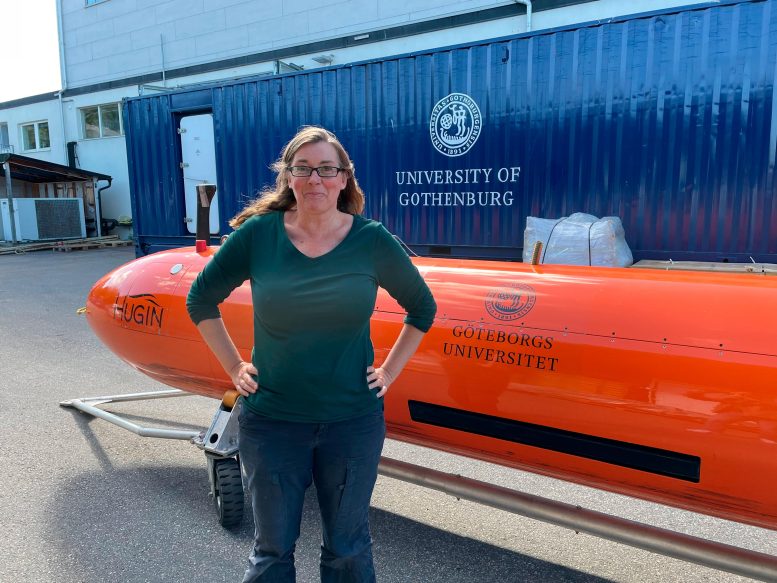The AUV is pre-programmed and then sent on long journeys under Antarctica's glaciers. Credit: Anna Wahlen
The unmanned underwater vehicle RAN disappeared under a glacier in Antarctica. The vehicle, owned by the University of Gothenburg, is one of three similar vehicles in the entire world being used for research and has contributed important knowledge about the so-called Doomsday Glacier.
Ran, a seven-metre-long ship, disappeared this weekend during an expedition with the South Korean icebreaker RV/IB Araon. The project is led by Professor Anna Valen, one of six participants from the University of Gothenburg. RAN is an unmanned underwater vehicle (AUV) equipped with modern technology and sensors that can measure and document surroundings in the water. It has the ability to conduct long missions under the ice, and has been used successfully in Antarctica, among other places.
Second visit
“This was the second time we took Ran Thwaites Glacier To document the area under the ice. Thanks to Rann, we became the first researchers in the world to enter Thwaites in 2019, and during the current expedition we have visited the same area again. Even if you see the melting ice and its movements from satellite data, from Ran we get close-ups of the underside of the ice and information about exactly the mechanisms behind the melting.
The Thwaites Glacier in Antarctica is massive and is sometimes called the Doomsday Glacier because it has the potential to raise global sea levels by several meters if it melts completely. Rann's measurements have received a lot of attention, and not just among polar scientists.

Anna Wallen with the unmanned underwater vehicle Ran in the main port of Gothenburg. Now the high-tech vehicle has disappeared under a glacier in Antarctica. Credit: Olof Loneheid
Losing contact with Ran
While diving under the 200-500 meter thick ice, Ran had no continuous contact with the research vessel. The route is pre-programmed, and thanks to the advanced navigation system, Ran can find her way back to the open water. What it looks like under a glacier is often completely unknown. Thus, the mission under a glacier is built in several stages, starting near the bottom and outside the ice to gradually increase difficulty and finally approaching the ice and making measurements at the interface between ice and water.
During January of this year, Rann completed several successful dives under Thwaites, but during the final dive planned for the expedition, something went wrong. After a long journey under the ice, the self-driving vehicle did not reach the programmed meeting point. The RV/IB Araon halted the repatriation flight and searches were conducted using acoustic search equipment, helicopters and drones, without success. In the end it was just a matter of realizing that Ran was lost.
Strong support from colleagues
“It's a bit like looking for a needle in a haystack, but without knowing where the haystack is,” says Anna Valen. “At this point, Rann’s batteries have died. All we know is that something unexpected has happened under the ice. We suspect it’s “He got into trouble, and then something prevented him from getting out.”
Anna Wallen is grateful for the support her team has received from the expedition management and points out that nothing has been done wrong by the ship, which, on the contrary, is the best icebreaker Rann has ever worked on.
A risky search
“The data we receive from Ran is unique in the world, and of great value for international research. At the same time, the stakes are high, we knew something like this could happen, even a possible end to Ran. Personally, I see this as a better end than having The aging AUV is gathering dust in the garage. At the same time, it is of course a very big loss. We have had the RAN for five years now, and during those five years we have carried out about ten missions, training, development and testing work.
The purchase of Ran was financed for SEK 38 million by the Knut and Alice Wallenberg Foundation in 2015. Even if the vehicle is lost, the organization still has a unique resource in the form of knowledge and well-trained staff. There are also terminal equipment, a receiving and launching system from large ships, spare parts, computers and analysis equipment.
“Our goal is to replace Rahn. We will look for a financier to cover the deductions made by the insurance company and the rate increases that have occurred over the years,” says Anna Whalen.

“Devoted student. Bacon advocate. Beer scholar. Troublemaker. Falls down a lot. Typical coffee enthusiast.”

